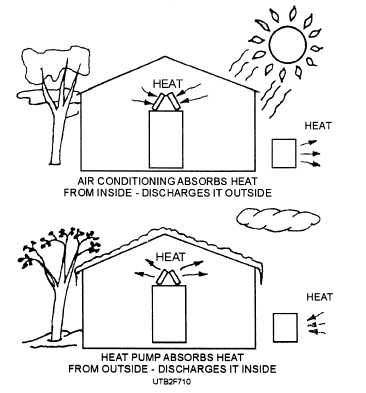winter, the condenser outside is picking up heat from the outside air because its temperature is lower than that of the outside air (until it reaches the balance point). This heat is then sent to the evaporator by the compressor and is given off into the conditioned space. A reversing valve is the key to this operation. The compressor always pumps in one direction, so the reversing valve changes the hot-gas direction from the condenser to the evaporator as indicated by the setting on the thermostat. The setting of the thermostat assures the operator of a constant temperature through an automatic change from heating to cooling anytime outside conditions warrant. Heat pumps are made not only for small homes but large homes and commercial buildings as well. The heat pump does not require an equipment room, and its minor noise is discharged into the atmosphere. The remote heat pump has only a blower and evaporator, which can be installed under the floor, in an attic, or other out-of-the-way location, depending on the application and its requirements. Supplemental heat can be added into the duct and be set to come on by a second stage of the thermostat, an outside thermosat, or both, depending on design of the system.
Heating Cycle
The initial heating demand of the thermostat starts the compressor. The reversing valve is de-energized during the heating mode. The compressor pumps the hot refrigerant gas through the indoor coil where heat is released into the indoor air stream. This supply of warmed air is distributed through the conditioned space. As the refrigerant releases its heat, it changes into a liquid, which is then transported to the outdoor coil. The outdoor coil absorbs heat from the air blown across the coil by the outdoor fan. The refrigerant changes from a liquid into a vapor, as it passes through the outdoor coil. The vapor returns to the compressor where it increases temperature and pressure. The hot refrigerant is then pumped back to the indoor coil to start another cycle. A graphic presentation of the nine steps of the cycle is shown in figure 7-11.
Cooling Cycle
Once the thermostat is put in the cooling mode, the reversing valve is energized. A cooling demand starts the compressor. The compressor pumps hot high-pressure gas to the outdoor coil where heat is released by the outdoor fan. The refrigerant changes into a liquid, which is transported to the indoor blower. The refrigerant absorbs heat from the indoor air of the

Figure 7-10. - Basic heat pump operation.
Continue Reading